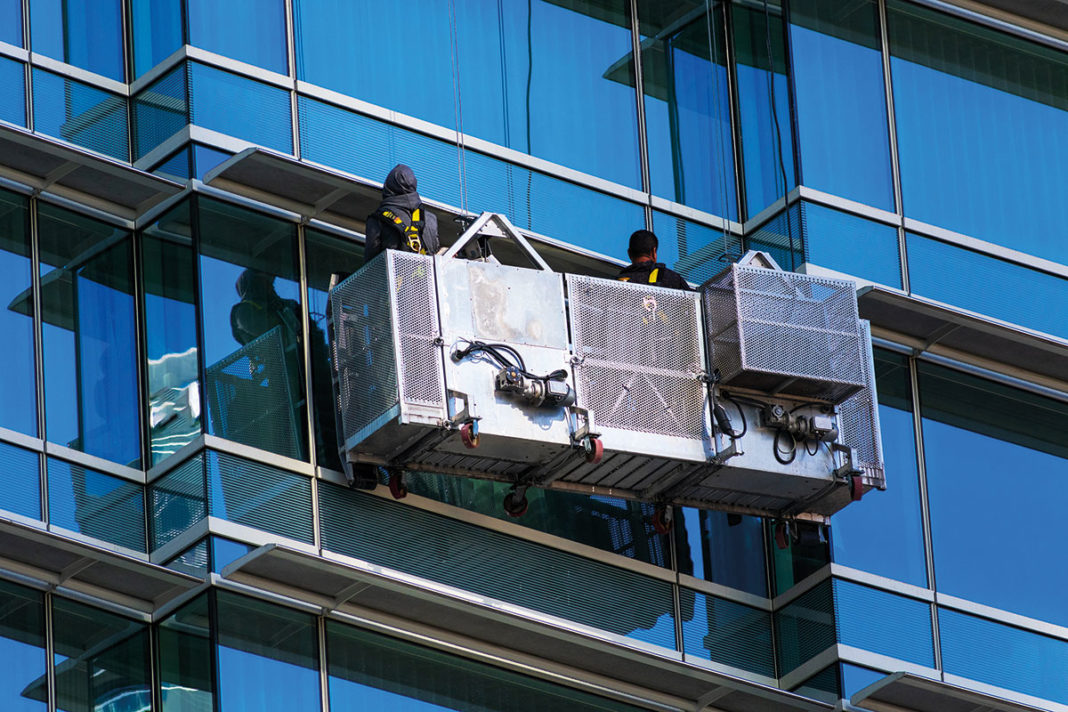By Mohamed Merchant, an associate director at TÜV SÜD Dunbar Boardman

AS cladding typically has a greater footprint than the actual building which it protects, it is no wonder that it accounts for 25-40% of the building cost. The term cladding also embraces a broad range of building envelope constructions, including traditional fully sealed and modern pressure-equalised cladding panels, curtain walling and structural glazing systems.
The selection of glazing systems (including materials and surrounds) should be influenced by:
• Suitable and safe access for cleaning, including consideration of any possible inconvenience caused to the building occupants.
• The ease and cost of materials replacement, such as façade panels.
• The ongoing cleaning and maintenance cost.
Despite its material and construction complexity, in simple terms the cladding on a building’s façade is expected to ‘keep the rain out’ and it must cope with a range of elemental forces, thermal loss and solar gain. The reality is that the integrity of some element of a façade is likely to fail and this must be proactively recognised and addressed.
Failure is said to have occurred when a system component does not function with design intent. Therefore, when applied to cladding, design intent parameters should encompass an element of time and cost to allow for failures.
When a failure is experienced, the warranty comes into play. Depending on the façade material used, a manufacturer will normally offer a five to 10-year warranty, which is covered by the insurance-appointed specialist façade contractor. However, warranties are conditional and full of exclusions, such as negligence, wear and tear, failure to handle and incorrect installation.
Warranties will not provide remedy for any damage, wholly or partially, if building owners fail to comply. This means that the building owner is responsible for adhering to the clauses within the warranty contract, and the façade system must be maintained as per the supplier’s manual. The façade access strategy must therefore be incontrovertible and include back-up solutions to ensure that cleaning and maintenance cycles are unaffected.
As all glazing systems are subject to some degradation over time by the action of the elements and building movement, periodic inspection (direct hands-on, close-up examination) and maintenance works should be carried out systematically.
For example, a thorough evaluation will include surveying the condition of the various gaskets and seals, to ascertain if the framing components are admitting water into the curtain wall system, as well as evaluating the thermal insulation capabilities of the vision and insulating panels of the system.
The inspection regime should not impair the integrity and performance of the façade system, and the frequency of maintenance and inspection will depend on the nature of the glazing material, its levels of exposure and the building’s location.
Façade contractors will specify the cleaning regime and frequency, to comply with the manufacturer’s warranty terms. This data should be made available to the façade access specialist during the concept/schematic design stages, to help them specify the most suitable types of façade access equipment. This will also allow the number of systems to be established, which will offer clarity in terms of spatial demands to accommodate multiple façade access systems on the roof and at ground level.

However, very often buildings are designed with little or no thought to the façade access strategy and maintenance crews find themselves having to work around inappropriate planning decisions.
For example, we have come across situations where a glazing detail has not been thought through in terms of how the glass might be replaced. It is very common to find on an internally glazed building that the glass cannot be brought into the finished building due to interior components. This, of course, defeats the object of having internal glazing in the first place.
Also, inefficient access, such as strategies relying on extended reach and wash poles, may invalidate warranties. It is therefore important to define the access options at the early stages of building design, so that the cleaning and maintenance strategies can be developed as part of the entire build programme.
Another issue that should be considered during the development of the façade access strategy is the impact of the external environment. While this is beyond the control of the building owner or maintenance organisation, it can nullify warranties. Potential defects caused by the environment must therefore be factored in and can be minimised if efficient maintenance strategies are considered early on.
For example, tall buildings are at greater risk than low-rise buildings, owing to their direct exposure to rain and ultraviolet radiation, which causes a greater rate and intensity of deterioration.
To ensure that façade warranties are maintained, the façade access designer must consider an array of interlinking elements and should involve all interested parties, including the building owner, cleaning company, cladding manufacturer and structural engineer. Without full and thorough consideration of everything that may impact warranty validity, any failure in a façade’s material could prove to be extremely costly.









